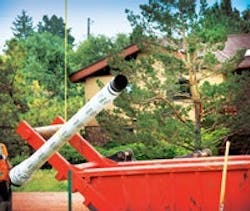Spanning Generations
For several generations, iron pipe has earned a reputation for strength and durability, having served North America for almost 200 years. Modern ductile iron pipe, made by the member companies of the Ductile Iron Pipe Research Assn. (DIPRA), continues that record of service. The advent of centrifugal casting and cement-mortar lining in the 1920s, the development of ductile iron pipe and polyethylene encasement in the 1950s, and the introduction, today, of the V-Bio enhanced polyethylene encasement are just a few examples of milestone moments in the ductile pipe industry’s past.
In 1958, a 4-in. cast iron water pipeline in Lafourche Parish, La., was installed in what was the first recorded use of polyethylene encasement to protect an iron pipeline from aggressive soils. Since that time, polyethylene encasement has been used to protect hundreds of millions of feet of iron pipe throughout North America and the world, providing effective and economical corrosion control. In 2013, the ductile iron pipe industry introduced the V-Bio product, an enhanced polyethylene encasement.
Historical Success
In the early 1950s, experimental loose polyethylene film was installed in test site locations in Birmingham, Ala.; Everglades City, Fla.; and Atlantic City, N.J. The resulting positive outcomes led to the introduction of polyethylene encasement as a way to mitigate the effects of corrosion on iron pipe. From that beginning, polyethylene encasement became the most commonly used method of iron pipe protection in North America and worldwide.
Polyethylene encasement does not require ongoing maintenance or monitoring. It is installed at the job site and, if damaged, is easily repaired. It isolates the pipe from surrounding soils and, while not intended to be watertight, the encasement provides a uniform environment that becomes inert over its first months of service.
The Lafourche Parish Water District No. 1 offers an example of 8-mm polyethylene encasement installed on cast iron pipe. The 4-in. cast iron water main was installed in a saturated, dark gray soil with black organics. The soil’s aggressive nature was demonstrated by a resistivity of 460 ohm-cm; a neutral pH; a negative redox potential; and a positive indication of the presence of sulfide. In 1972, the pipeline was excavated and inspected to see how well the polyethylene encasement was working.
The results were positive. The pipeline was inspected again in 1981 and in 1990 and then beginning in 1993, it was inspected every five years—including most recently in 2013. These excavations involved removing surrounding soil from the pipe to observe the quality of the installation and to preserve the polyethylene film for subsequent testing. Then, the original encasement was removed on a section of the pipe and the pipe was inspected for evidence of corrosion. In every case, the pipe was found to be in excellent condition. From each inspection, a sample of the original film was sent to DIPRA’s laboratory for testing, with the results meeting the requirements for strength and elongation found in the original American Water Works Assn. (AWWA) standard for polyethylene encasement. At the conclusion of each inspection, the exposed portion of the pipe was encased in new 8-mm polyethylene prior to backfilling, leaving the original polyethylene encasement on the sections of the pipe that had not been inspected.
Based on polyethylene encasement’s success, in 1972, AWWA adopted the first national standard, ANSI/AWWA C105/A21.5. Two years later, the American Society for Testing and Materials issued a standard—ASTM A674—for polyethylene encasement, and an international standard was issued in 1985.
A New Generation
In 2013, the V-Bio enhanced polyethylene encasement was introduced. The product is a polyethylene encasement that adds an active component to the protection offered by polyethylene encasement. Manufactured using three layers of co-extruded polyethylene film, the V-Bio encasement is infused with an anti-microbial and a corrosion inhibitor. Meeting all of the requirements found in ANSI/AWWA C105/A21.5 for linear low-density polyethylene, the product actively repels the anaerobic bacteria that can have a negative influence on corrosion rates and prevents the development of corrosion cells under the encasement. Moreover, because of the way they work, these additives are not consumed while protecting the pipe.
In the summer of 2014, the first project designed to evaluate the long-term performance of the V-Bio encasement in an operating water system was installed in Colorado Springs, Colo. In cooperation with Colorado Springs Utilities, DIPRA installed corrosion probes in two locations over one section of a V-Bio encased, cathodically protected 8-in. water main. At each location, two corrosion probes were installed under the film (one connected to the cathodic protection system, and one not connected) and a third probe was installed directly in the soil. Periodic measurements will be taken to calculate corrosion rates as an indication of how well the encasement protects the pipe. Baseline readings were taken, the soil was tested to document its corrosivity, and the V-Bio used in that installation was tested for its physical characteristics and the presence of the additives. In the coming years, regular measurements will continue to be taken, and at some point in the future, the pipeline will be excavated and inspected to verify the
encasement’s protection.
Research into the effectiveness of the V-Bio enhanced polyethylene encasement will provide engineers and utilities with information they can use to determine effective options for their water and wastewater infrastructure.
Download: Here
